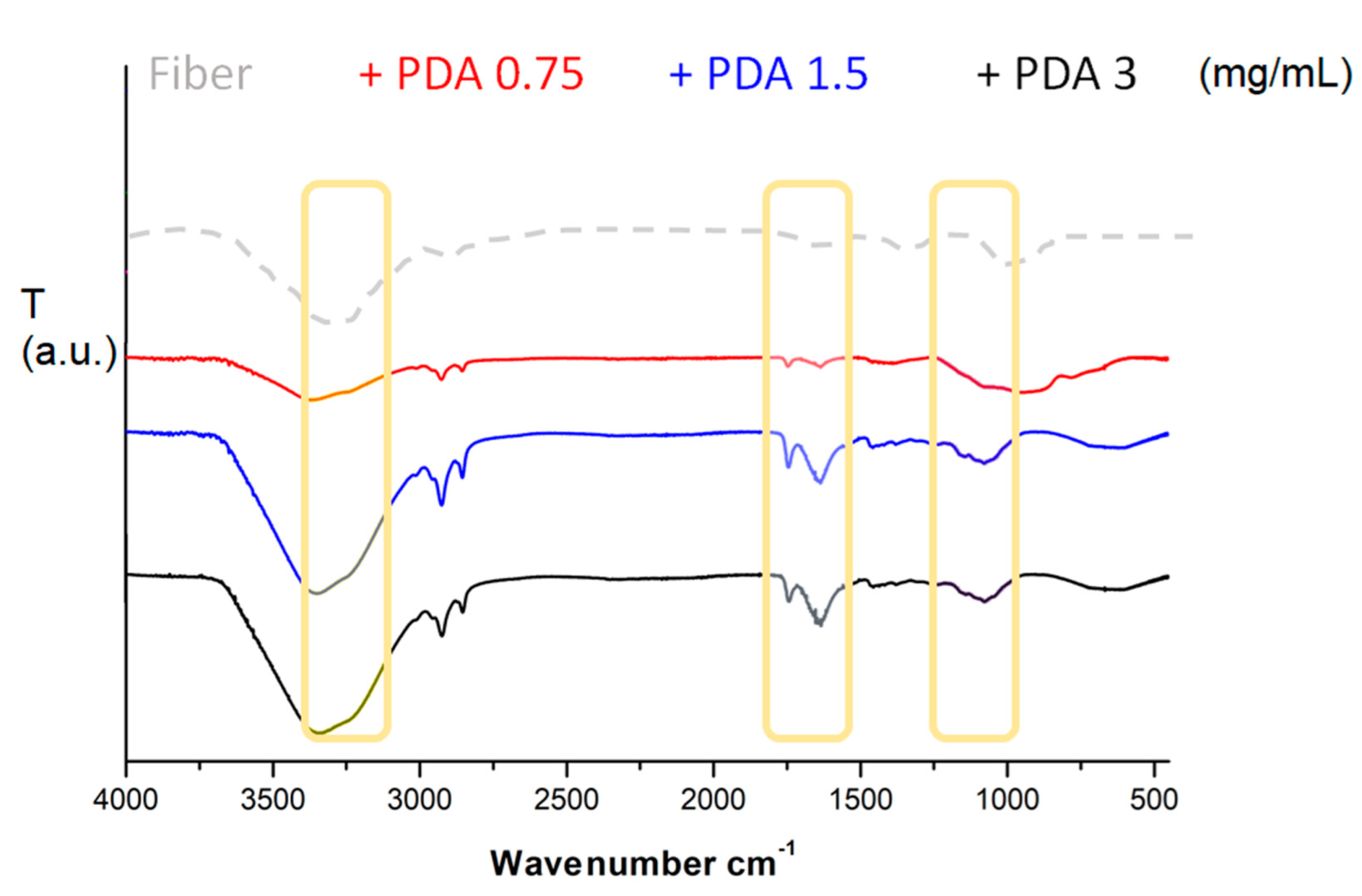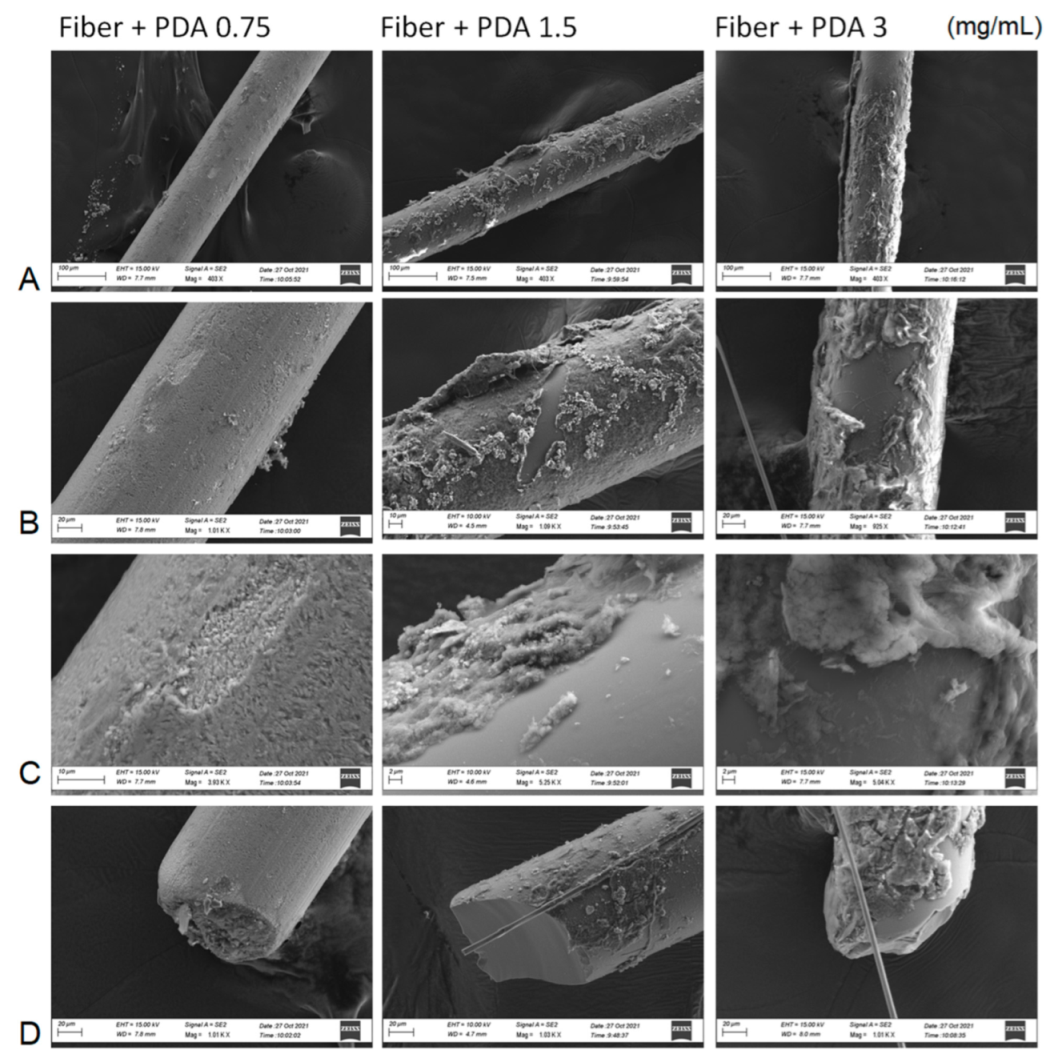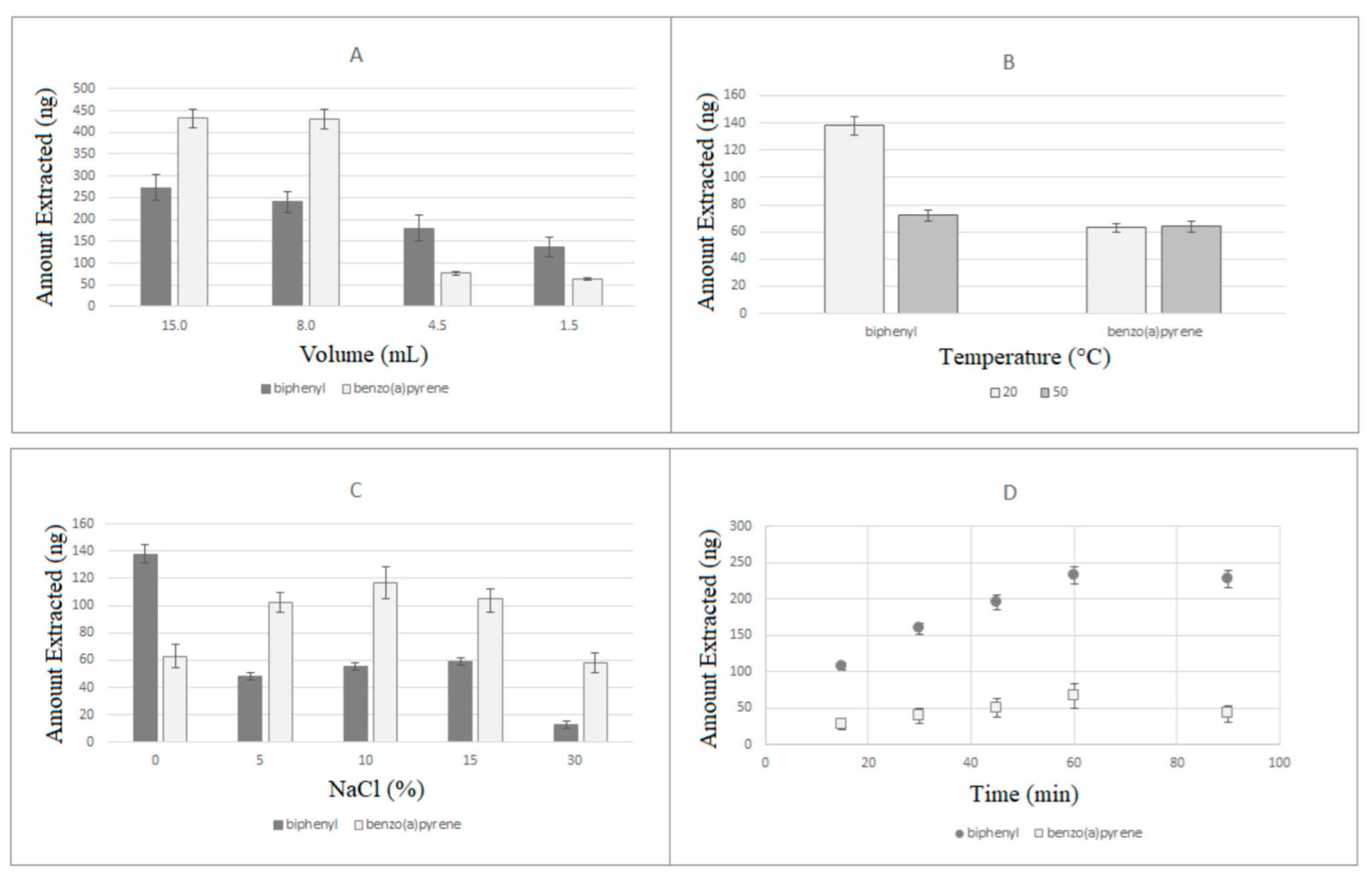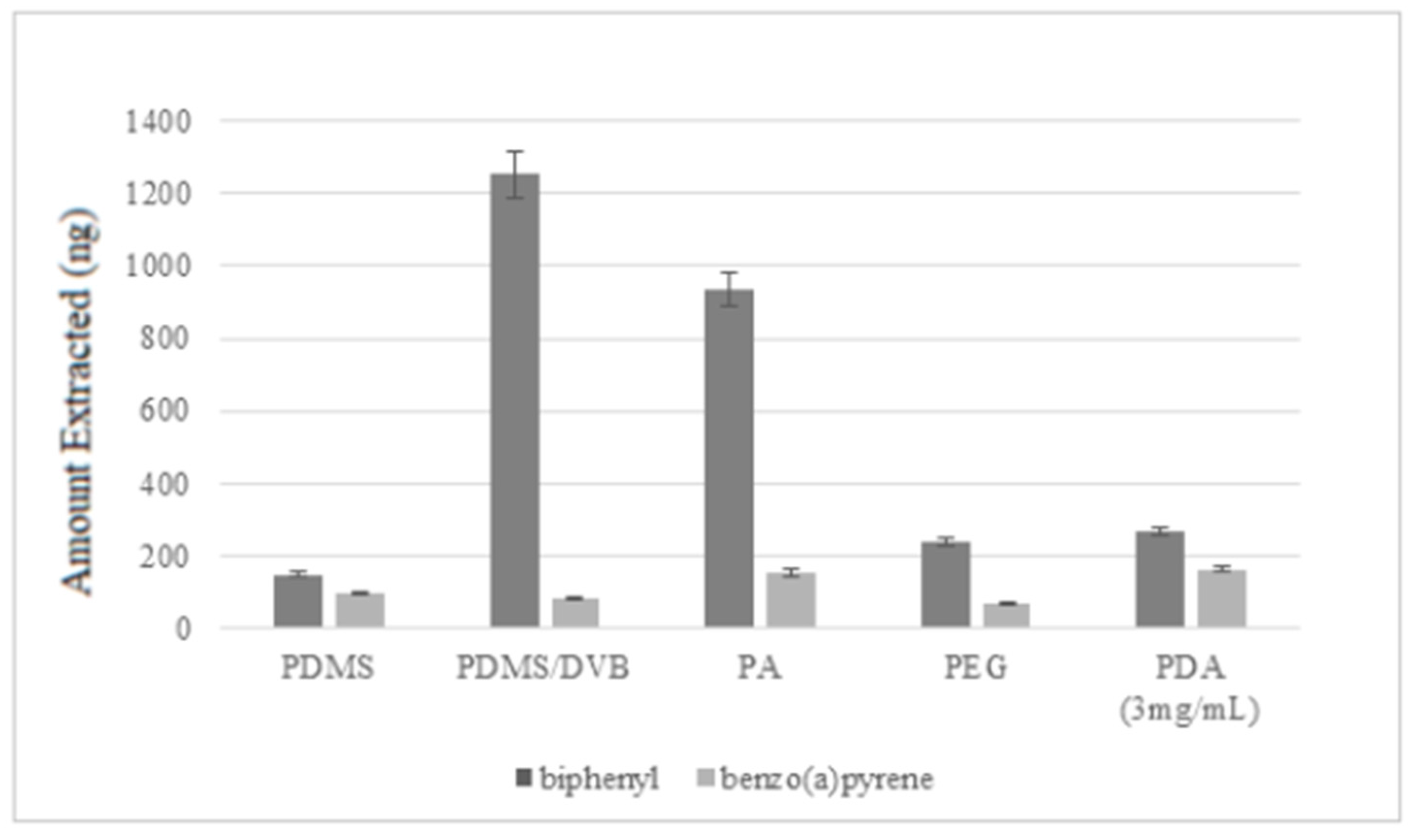Mussel Inspired Polydopamine as Silica Fibers Coating for Solid-Phase Microextraction
Abstract
:1. Introduction
2. Materials and Methods
2.1. Materials
2.2. Polydopamine Fibers Coating
2.3. Solid-Phase Microextraction
2.4. Apparatus and Instrumental Conditions
2.5. Chromatographic Conditions
2.6. Sample Preparation
3. Results
3.1. Characterization of the PDA Coated Fiber
3.2. Optimization of the SPME Procedure
3.3. Soot Samples Analysis
4. Discussion
5. Conclusions
Author Contributions
Funding
Institutional Review Board Statement
Informed Consent Statement
Data Availability Statement
Acknowledgments
Conflicts of Interest
References
- Zambonin, C.; Aresta, A. Recent Applications of Solid Phase Microextraction Coupled to Liquid Chromatography. Separations 2021, 8, 34. [Google Scholar] [CrossRef]
- Moliner-Martinez, Y.; Herráez-Hernández, R.; Verdú-Andrés, J.; Molins-Legua, C.; Campíns-Falcó, P. Recent advances of in-tube solid-phase microextraction. Trends Anal. Chem. 2015, 71, 205–213. [Google Scholar] [CrossRef]
- Li, J.; Wang, Y.B.; Li, K.Y.; Cao, Y.Q.; Wu, S.; Wu, L. Advances in different configurations of solid-phase microextraction and their applications in food and environmental analysis. Trends Anal. Chem. 2015, 72, 141–152. [Google Scholar] [CrossRef]
- Seidi, S.; Tajik, M.; Baharfar, M.; Rezazadeh, M. Micro solid-phase extraction (pipette tip and spin column) and thin film solid-phase microextraction: Miniaturized concepts for chromatographic analysis. Trends Anal. Chem. 2019, 118, 810–827. [Google Scholar] [CrossRef]
- Bagheri, H.; Piri-Moghadam, H. Recent advances in capillary microextraction. Trends Anal. Chem. 2015, 73, 64–80. [Google Scholar] [CrossRef]
- Ozturk, E.E.; Bozyigit, G.D.; Buyukpınar, C.; Bakırdere, S. Magnetic Nanoparticles Based Solid Phase Extraction Methods for the Determination of Trace Elements. Crit. Rev. Anal. Chem. 2022, 52, 231–249. [Google Scholar] [CrossRef]
- Xu, J.; Zheng, J.; Tian, J.; Zhu, F.; Zeng, F.; Su, C.; Ouyang, G. New materials in solid-phase microextraction. Trends Anal. Chem. 2013, 47, 68–83. [Google Scholar] [CrossRef]
- Yin, L.; Xu, J.; Huang, Z.; Chen, G.; Zheng, J.; Ouyang, G. Solid-Phase Microextraction Fibers Based on Novel Materials: Preparation and Application. Prog. Chem. 2017, 29, 1127–1141. [Google Scholar]
- Piri-Moghadam, H.; Alam, M.N.; Pawliszyn, J. Review of geometries and coating materials in solid phase microextraction: Opportunities, limitations, and future perspectives. Anal. Chim. Acta 2017, 984, 42–65. [Google Scholar] [CrossRef] [Green Version]
- Hashemi, B.; Zohrabi, P.; Shamsipur, M. Recent developments and applications of different sorbents for SPE and SPME from biological samples. Talanta 2018, 187, 337–347. [Google Scholar] [CrossRef]
- Lashgari, M.; Yamini, Y. An overview of the most common lab-made coating materials in solid phase microextraction. Talanta 2019, 191, 283–306. [Google Scholar] [CrossRef] [PubMed]
- Sajid, M.; Khaled Nazal, M.; Rutkowska, M.; Szczepa´nska, N.; Namie´snik, J.; Płotka-Wasylka, J. Solid Phase Microextraction: Apparatus, Sorbent Materials, and Application. Crit. Rev. Anal. Chem. 2019, 49, 271–288. [Google Scholar] [CrossRef] [PubMed]
- Guo, J.; Park, S.J.; Meng, L.Y.; Jin, X. Applications of carbon-based materials in solid phase micro-extraction: A review. Carbon Lett. 2017, 24, 10–17. [Google Scholar]
- Rocío-Bautista, P.; Pacheco-Fernández, I.; Pasán, J.; Pino, V. Are metal-organic frameworks able to provide a new generation of solid-phase microextraction coatings? A review. Anal. Chim. Acta 2016, 939, 26–41. [Google Scholar] [CrossRef] [PubMed]
- Li, G.; Row, K.H. Recent Applications of Molecularly Imprinted Polymers (MIPs) on Micro-extraction Techniques. Sep. Purif. Rev. 2018, 47, 1–18. [Google Scholar] [CrossRef]
- Yu, H.; Ho, T.D.; Anderson, J.L. Ionic liquid and polymeric ionic liquid coatings in solid-phase microextraction. Trends Anal. Chem. 2013, 45, 219–232. [Google Scholar] [CrossRef]
- Patinha, D.J.S.; Silvestre, A.J.D.; Marrucho, I.M. Poly (ionic liquids) in solid phase microextraction: Recent advances and perspectives. Prog. Polym. Sci. 2019, 98, 101148. [Google Scholar] [CrossRef]
- Yavir, K.; Konieczna, K.; Marcinkowski, L.; Kloskowski, A. Ionic liquids in the microextraction techniques: The influence of ILs structure and properties. Trends Anal. Chem. 2020, 45, 219–232. [Google Scholar] [CrossRef]
- McLean, M.; Malik, A. Comprehensive Sampling and Sample Preparation; Pawliszyn, J., Ed.; Elsevier: Amsterdam, The Netherlands, 2012; pp. 311–329. [Google Scholar]
- Kabir, A.; Furton, K.G.; Malik, A. Innovations in sol-gel microextraction phases for solvent-free sample preparation in analytical chemistry. Trends Anal. Chem. 2013, 45, 197–218. [Google Scholar] [CrossRef]
- Murtada, K. Trends in nanomaterial-based solid-phase microextraction with a focus on environmental applications—A review. Trends Envrion. Anal. 2020, 25, 00077. [Google Scholar] [CrossRef]
- Amiri, A. Solid-phase microextraction-based sol–gel technique. Trends Anal. Chem. 2016, 75, 57–74. [Google Scholar] [CrossRef]
- Che, D.; Cheng, J.; Ji, Z.; Zhang, S.; Li, G.; You, J. Recent advances and applications of polydopamine-derived adsorbents for sample pretreatment. Trends Anal. Chem. 2017, 97, 1–14. [Google Scholar] [CrossRef]
- Lee, H.; Rho, J.; Messersmith, P.B. Facile conjugation of biomolecules onto surfaces via mussel adhesive protein inspired coatings. Adv. Mater. 2009, 21, 431–434. [Google Scholar] [CrossRef] [Green Version]
- Lee, H.A.; Park, E.; Lee, H. Polydopamine and Its Derivative Surface Chemistry in Material Science: A Focused Review for Studies at KAIST. Adv. Mater. 2020, 32, 1907505. [Google Scholar] [CrossRef] [PubMed]
- Zhang, X.; Wang, S.; Xu, L.; Feng, L.; Ji, Y.; Tao, L.; Wei, Y. Biocompatible polydopamine fluorescent organic nanoparticles: Facile preparation and cell imaging. Nanoscale 2012, 4, 5581–5584. [Google Scholar] [CrossRef] [PubMed]
- Zhanga, S.; Yao, W.; Ying, J.; Zhao, H. Polydopamine-reinforced magnetization of zeolitic imidazolate framework ZIF-7 for magnetic solid-phase extraction of polycyclic aromatic hydrocarbons from the air-water environment. J. Chromatogr. A 2016, 1452, 18–26. [Google Scholar] [CrossRef] [PubMed]
- Wanga, Y.; Wanga, S.; Niu, H.; Ma, Y.; Zeng, T.; Cai, Y.; Meng, Z. Preparation of polydopamine coated Fe3O4 nanoparticles and their application for enrichment of polycyclic aromatic hydrocarbons from environmental water samples. J. Chromatogr. A 2013, 1283, 20–26. [Google Scholar] [CrossRef] [PubMed]
- Cai, Y.; Yan, Z.; Yang, M.; Huang, X.; Min, W.; Wang, L.; Cai, Q. Polydopamine decorated 3D nickel foam for extraction of sixteen polycyclic aromatic hydrocarbons. J. Chromatogr. A 2016, 1478, 2–9. [Google Scholar] [CrossRef] [Green Version]
- Fenga, J.; Suna, M.; Li, J.; Xua, L.; Liu, X.; Jiang, S. Polydopamine supported preparation method for solid-phase microextraction coatings on stainless steel wire. J. Chromatogr. A 2011, 1218, 3601–3607. [Google Scholar] [CrossRef]
- Vona, D.; Cicco, S.R.; Ragni, R.; Vincente-Garcia, C.; Leone, G.; Giangregorio, M.M.; Palumbo, F.; Altamura, E.; Farinola, G.M. Polydopamine coating of living diatom microalgae. Photochem. Photobiol. Sci. 2022, 21, 945–958. [Google Scholar] [CrossRef]
- Grieco, C.; Kohl, F.R.; Hanes, A.T.; Kohler, B. Probing the heterogeneous structure of eumelanin using ultrafast vibrational fingerprinting. Nat. Commun. 2020, 11, 4569. [Google Scholar] [CrossRef]
- Vona, D.; Cicco, S.R.; Ragni, R.; Leone, G.; Lo Presti, M.; Farinola, G.M. Biosilica/polydopamine/silver nanoparticles composites: New hybrid multifunctional heterostructures obtained by chemical modification of Thalassiosira weissflogii silica shells. MRS Commun. 2018, 8, 911–917. [Google Scholar] [CrossRef]
- Yun, L. High extraction efficiency solid-phase microextraction fibers coated with open crown ether stationary phase using sol–gel technique. Anal. Chim. Acta 2003, 486, 63–72. [Google Scholar] [CrossRef]
- Kim, T.Y.; Alhooshani, K.; Kabir, A.; Fries, D.P.; Malik, A. High pH-resistant, surface-bonded sol–gel titania hybrid organic–inorganic coating for effective on-line hyphenation of capillary microextraction (in-tube solid-phase microextraction) with high-performance liquid chromatography. J. Chromatogr. A 2004, 1047, 165–174. [Google Scholar] [CrossRef]
- Kumar, A.; Malik, A.K.; Tewary, D.K.; Singh, B. A review on development of solid phase microextraction fibers by sol–gel methods and their applications. Anal. Chim. Acta 2008, 610, 1–14. [Google Scholar] [CrossRef] [PubMed]
- Presti, M.L.; Ragni, R.; Vona, D.; Leone, G.; Cicco, S.; Farinola, G.M. In vivo doped biosilica from living Thalassiosira weissflogii diatoms with a triethoxysilyl functionalized red emitting fluorophore. MRS Adv. 2018, 3, 1509–1517. [Google Scholar] [CrossRef]
- Stanisław, P.; Nawała, J.; Czupryński, K. Preparation and application of sol–gel acrylate and methacrylate solid-phase microextraction fibres for gas chromatographic analysis of organoarsenic compounds. Anal. Chim. Acta 2014, 837, 52–63. [Google Scholar]







| Parameter | Biphenyl | Benzo(a)pyrene | ||
|---|---|---|---|---|
| PDA | PA | PDA | PA | |
| Linear range | 0.010–1 µg/mL | 0.003–3 µg/mL | 0.050–1 µg/mL | 0.100–3 µg/mL |
| Equation | y = 129,661x + 3338 | y = 895,434x + 2931 | y = 370,910x + 15,390 | y = 200,304x + 19,203 |
| R2 | 0.9993 | 0.9995 | 0.9996 | 0.9994 |
| LOD | 0.007 | 0.001 | 0.016 | 0.030 |
| LOQ | 0.023 | 0.003 | 0.054 | 0.100 |
| Within-day | 5.5% | 6.0% | 6.9% | 7.1% |
| Between-day | 10.2% | 9.3% | 10.0% | 10.6% |
| PA | ||||||
|---|---|---|---|---|---|---|
| Analyte | ʎ-max (nm) | Equation | R2 | LOD (ng/mL) | LOQ (ng/mL) | RSD % |
| naphthalene | 275 | y = 4 × 106x + 16,672 | 0.9998 | 2.2 | 7.3 | 10 |
| biphenyl | 247 | y = 4 × 106x – 14,358 | 0.9993 | 2.0 | 6.7 | 9 |
| acenaphthene | 226 | y = 7 × 106x – 22,425 | 0.9985 | 1.5 | 5.0 | 11 |
| anthracene | 251 | y = 2 × 106x + 1865 | 0.9999 | 3.5 | 11.6 | 10 |
| pyrene | 239 | y = 8 × 105x + 873 | 0.9990 | 4.7 | 15.6 | 9 |
| chrysene | 267 | y = 2 × 105x + 3008 | 0.9084 | 29.7 | 98.9 | 12 |
| benzo(k)fluoranthene | 306 | y = 2 × 105x + 3741 | 0.9285 | 44.2 | 147.3 | 12 |
| benzo(a)pyrene | 295 | y = 2 × 105x + 4030 | 0.9186 | 69.2 | 230.4 | 12 |
| benzo(ghi)perylene | 298 | y = 4 × 104x + 6214 | 0.9083 | 24.7 | 82.2 | 13 |
| PDA | ||||||
| Analyte | ʎ-max (nm) | Equation | R2 | LOD (ng/mL) | LOQ (ng/mL) | RSD % |
| naphthalene | 275 | y = 9 × 105 − 8229 | 0.9913 | 9.2 | 30.6 | 12 |
| biphenyl | 247 | y = 1 × 105x – 21,299 | 0.9911 | 8.2 | 27.3 | 10 |
| acenaphthene | 226 | y = 2 × 106 – 52,369 | 0.9986 | 5.2 | 17.3 | 12 |
| anthracene | 251 | y = 2 × 106 – 39,062 | 0.9987 | 3.6 | 12.0 | 13 |
| pyrene | 239 | y = 9 × 105 – 28,916 | 0.9994 | 4.6 | 15.3 | 10 |
| chrysene | 267 | y = 6 × 105 – 11,471 | 0.9991 | 9.8 | 32.6 | 9 |
| benzo(k)fluoranthene | 306 | y = 7 × 105 – 11,663 | 0.9992 | 14.6 | 48.6 | 10 |
| benzo(a)pyrene | 295 | y = 7 × 105 – 12,287 | 0.9990 | 18.7 | 62.2 | 11 |
| benzo(ghi)perylene | 298 | y = 5 × 104 − 9957 | 0.9991 | 22.2 | 73.9 | 10 |
| Analyte | ng/mL | µg/g |
|---|---|---|
| naphthalene | 61.2 ± 7.5 | 24.5 ± 3.0 |
| biphenyl | 30.3 ± 4.7 | 12.1 ± 1.9 |
| acenaphthene | 46.8 ± 4.8 | 18.7 ± 1.9 |
| anthracene | 12.9 ± 2.2 | 5.2 ± 0.9 |
| pyrene | 52.1 ± 5.2 | 20.8 ± 2.1 |
| chrysene | 35.5 ± 3.5 | 14.2 ± 1.4 |
| benzo(ghi)perylene | LOD | 9.5 ± 2.1 |
Publisher’s Note: MDPI stays neutral with regard to jurisdictional claims in published maps and institutional affiliations. |
© 2022 by the authors. Licensee MDPI, Basel, Switzerland. This article is an open access article distributed under the terms and conditions of the Creative Commons Attribution (CC BY) license (https://creativecommons.org/licenses/by/4.0/).
Share and Cite
Aresta, A.; Cicco, S.R.; Vona, D.; Farinola, G.M.; Zambonin, C. Mussel Inspired Polydopamine as Silica Fibers Coating for Solid-Phase Microextraction. Separations 2022, 9, 194. https://doi.org/10.3390/separations9080194
Aresta A, Cicco SR, Vona D, Farinola GM, Zambonin C. Mussel Inspired Polydopamine as Silica Fibers Coating for Solid-Phase Microextraction. Separations. 2022; 9(8):194. https://doi.org/10.3390/separations9080194
Chicago/Turabian StyleAresta, Antonella, Stefania R. Cicco, Danilo Vona, Gianluca Maria Farinola, and Carlo Zambonin. 2022. "Mussel Inspired Polydopamine as Silica Fibers Coating for Solid-Phase Microextraction" Separations 9, no. 8: 194. https://doi.org/10.3390/separations9080194
APA StyleAresta, A., Cicco, S. R., Vona, D., Farinola, G. M., & Zambonin, C. (2022). Mussel Inspired Polydopamine as Silica Fibers Coating for Solid-Phase Microextraction. Separations, 9(8), 194. https://doi.org/10.3390/separations9080194










